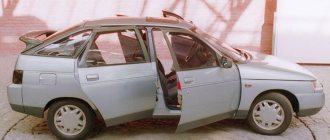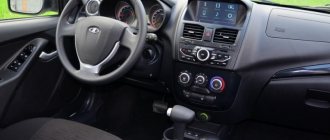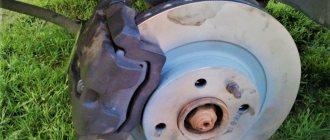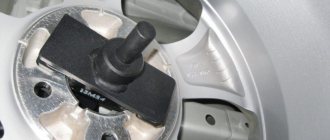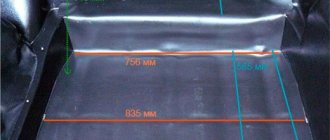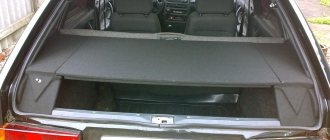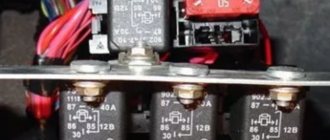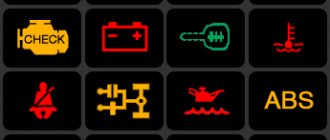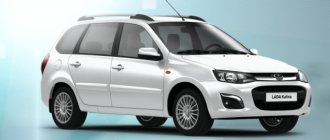Performance characteristics of the VAZ 2106 six
Maximum speed:
150 km/h
Acceleration time to 100 km/h:
17.5 sec
Fuel consumption per 100 km in the city:
10.1 l
Gas tank volume:
39 l
Curb vehicle weight:
1035 kg
Permissible gross weight:
1435 kg
Tire size:
175/70 SR13
Engine characteristics
Location:
front, longitudinal
Engine capacity:
1569 cm3
Engine power:
75 hp
Number of revolutions:
5400
Torque:
116/3000 N*m
Power system:
Carburetor
Turbocharging:
no
Gas distribution mechanism:
OHC
Cylinder arrangement:
In-line
Number of cylinders:
4
Cylinder diameter:
79 mm
Piston stroke:
80 mm
Compression ratio:
8.5
Number of valves per cylinder :
2
Recommended fuel:
AI-92
Brake system
Front brakes:
Disc
Rear Brakes:
Drum
Steering
Steering type:
Worm gear
Power steering:
no
Transmission
Drive unit:
Rear
Number of gears:
manual gearbox - 4
Gear ratio of the main pair:
4.1
Suspension
Front suspension:
Double wishbone
Rear suspension:
Coil spring
Body
Body type:
sedan
Number of doors:
4
Number of seats:
5
Car length:
4166 mm
Car width:
1611 mm
Car height
1440
Wheelbase:
2424 mm
Front track:
1365 mm
Rear track:
1321 mm
Ground clearance (clearance):
170 mm
Trunk volume:
345 l
Production
Year of issue:
from 1976 to 2005
Modifications of VAZ 2106
VAZ-21061
— VAZ-2103 engine with a volume of 1500 cm3. Initially, this index was supposed to denote a special version for Canada, which included being equipped with special bumpers - aluminum, without fangs, with linings and ends made of black plastic.
VAZ-21062
— export modification of the VAZ-2106 with right-hand drive.
VAZ-21063
— an improved VAZ-21011 engine, with an oil pressure sensor and an electric fan instead of a belt-driven impeller (in a variant, belt drive was allowed).
VAZ-21064
— export modification of the VAZ-21061 with right-hand drive.
VAZ-21065
- a modernized modification with improved equipment, produced in 1990 - 2001. It differed from the base model by a more powerful generator, a five-speed gearbox, a rear axle gearbox with a gear ratio of 3.9, a contactless ignition system, a Solex carburetor (21053-1107010), halogen headlights, seat upholstery and headrests, as well as a standard rear fog lamp and electrically heated rear window. Equipment 21065-01 was equipped with an engine from model 2103.
VAZ-21066
— export modification of the VAZ-21063 with right-hand drive.
VAZ-21067
- IzhAvto assemblies. The VAZ-21067 engine, which differs from the base one by the presence of a fuel injection system with a catalytic converter, which ensures compliance with Euro-2 toxicity standards.
VAZ-21068
- was released as a carrier of units during the development of the new VAZ-2108 and VAZ-21083 engines.
VAZ-21069
— cars were manufactured for special services. Externally, it is completely identical to the VAZ-2106, but with a two-section VAZ-411 RPD with a power of 120 hp. Since 1983, a VAZ-413 engine with a power of 140 hp could be installed, and since 1997, a universal RPD for rear-wheel drive and front-wheel drive VAZ VAZ-415.
VAZ-2106 "Tourist"
- a pickup truck with a tent built into the body, created by order of the technical directorate. The project was rejected by the plant's head management, and the only silver copy was repainted red and subsequently used as in-plant technical equipment.
VAZ-2106 “Half past six”
- the only copy made according to a special order received from L. I. Brezhnev or someone from his circle after the demonstration of experienced VAZ-2107 to the top leadership of the USSR in 1979. In addition to export bumpers, it differed in seats and radiator grille from 2107, as well as hood modified for its installation.
Nowadays, few people are interested in such a characteristic of a car as its weight, and if they are interested, then in the last place. It is much more important for the average person to know his appetite, speed, cost and other indicators. Although, by and large, the weight of the car actually affects all its other indicators.
For example, the heavier the car, the more powerful the engine must be installed in it so that it can reach the required speed and accelerate to 100 km in a matter of seconds. The same can be said about fuel consumption - the heavier the vehicle, the more gasoline or diesel fuel it will need to move.
A car's directional stability and handling are also directly related to its weight. The peak of popularity of large, heavy cars abroad occurred in the 50-60s of the last century. Then the auto industry produced truly gigantic cars. For example, the Cadillac Eldorado modification 8.2 weighed almost 3 tons. Agree that for such a weight, an appropriate makeweight is needed.
But as time passed, it became clear that in order to further develop and improve the most important characteristics of the car, it was necessary to resort to reducing its overall weight.
And if we compare the middle of the last century and today, cars have lost half, or even more, of their own weight. Plastic, carbon fiber reinforced plastic, light metals - all these innovations have made it possible to make the weight of a passenger car significantly lower.
Of course, for lovers of everything big and heavy, cars are produced that look like steamships that drink buckets of gasoline, but this is rather an exception to the rule.
Car weights, table
We present to your attention a table that shows the weight of the car by brand.
| Brand | Model | Curb vehicle weight (kg) |
| Oka | 1111 | 635 |
| 1113 | 645 | |
| VAZ | 2101 | 955 |
| 2102 | 1010 | |
| 2103 | 965 | |
| 2104, 2110 | 1020 | |
| 2105 | 1060 | |
| 2106 | 1045 | |
| 2107 | 1049 | |
| 2108 | 945 | |
| 2109 | 915 | |
| 2111 | 1055 | |
| 2112 | 1040 | |
| 2113 | 975 | |
| 2114 | 985 | |
| 2115 | 1000 | |
| 2116 | 1276 | |
| 2117, 18, 19,20 | 1080 | |
| Niva | 2121 | 1150 |
| Gazelle | 3302 | 1850 |
| 33023 | 2050 | |
| 33027, 330202 | 2100 | |
| 330273 | 2300 | |
| 2705 | 2000 | |
| 2057 | 2220 | |
| 330232 | 2170 | |
| Sable | 2752 | 1880 |
| 2217, 22171 | 2130 | |
| Chevrolet | Cruz | 1285-1315 |
| Niva | 1410 | |
| GAZ (Volga) | 24, 2401 | 1420 |
| 2402, 2403,2404 | 1550 | |
| 2407 | 1560 | |
| GAZ (truck) | 53 | 3250 |
| 66 | 3440 | |
| 69 (8 seats) | 1525 | |
| 69A (5 seats) | 1535 | |
| ZIL | 130 | 4300 |
| 131 | 6790 | |
| 157KD | 5050 | |
| 433360 | 4475 | |
| 431410 | 4175 | |
| 431510 | 4550 | |
| MAZ | 5551 | 7470 |
| 53366 | 8200 | |
| Ural | 375 | 7700-8000 |
| 377 | 6830-7275 | |
| 4320 | 9750 | |
| 5557 | 9980 | |
| Muscovite | 412 | 1045 |
| 2140 | 1080 | |
| 2141 | 1055 | |
| 2335, 407, 408 | 990 | |
| UAZ | 3962, 452 (loaf) | 1825 |
| 469 | 1650 | |
| Patriot | 2070 | |
| Hunter | 1815 | |
| Nissan | x trail (x-trail) | 1410-1690 |
| Qashqai | 1297-1568 | |
| Juke | 1162 | |
| Ford | Focus | 965-1007 |
| Focus 2 | 1345 | |
| Focus 3 | 1461-1484 | |
| Kuga | 1608-1655 | |
| Escort | 890-965 | |
| Renault | Logan | 957-1165 |
| Duster | 1340-1450 | |
| Sandero | 941 | |
| Opel | Mocha | 1329-1484 |
| Astra | 950-1105 | |
| Mazda | 3 | 1245-1306 |
| cx-5 | 2035 | |
| 6 | 1245-1565 | |
| Volkswagen | Tuareg | 2165-2577 |
| Polo | 1173 | |
| Passat | 1260-1747 | |
| Toyota | Camry | 1312-1610 |
| Corolla | 1215-1435 | |
| Celica | 1000-1468 | |
| Land Cruiser | 1896-2715 | |
| Skoda | Octavia | 1210-1430 |
| Fabia | 1015-1220 | |
| Yeti | 1505-1520 | |
| Kia | Sportage | 1418-1670 |
| Ceed | 1163-1385 | |
| Picanto | 829-984 |
Thus, it turns out that if we take, so to speak, “in general for the hospital,” then the average weight of a passenger car is approximately 1 to 1.5 tons.
How much does the VAZ 2106 body weigh and what are its dimensions? People often ask on forums and car portals. Indeed, interest in the most popular car in the post-Soviet space was and remains incredibly high. Find out more by reading useful information on the body of this car. A lot depends on how much the body of the VAZ 2106 weighs, including the condition of the main parameters of the car.
How much does a VAZ car sold for scrap weigh?
How much does the VAZ 2101 weigh?
The most common vehicles in the post-Soviet space have always been considered to be the products of the Volga automobile industry. These cars faithfully served their owners for decades. Therefore, the question of how much a VAZ 2107 weighs for scrap metal does not surprise anyone. The same applies to other car models that are subject to recycling. The Lada Seven, according to documents, has a mass of 1049 kg. However, its weight is practically no different from any other brand of car from the Volzhsky Automobile Plant. The average weight of this Soviet car, which is often scrapped, is around one ton.
Sometimes owners of relatively new cars have to go to a metal collection point. The vehicle may be damaged as a result of an accident or other accident. In some situations, from an economic point of view, the only right decision would be to scrap the car.
Sometimes drivers prefer to disassemble the car themselves. Therefore, the relevance of the question of how much a VAZ 2101 body weighs for scrap metal is understandable. Considering that Kopeyka is the oldest representative of this line of the domestic automobile industry, it is the leader among cars that can be recycled. Its scrap weight is 955 kg, of which the body takes up about 280.
Body weight
ATTENTION! A completely simple way to reduce fuel consumption has been found! Don't believe me? An auto mechanic with 15 years of experience also didn’t believe it until he tried it. And now he saves 35,000 rubles a year on gasoline!
Let’s say right away that the “six” weighs exactly 1045 kg. Its mass is decomposed as follows:
- The weight of the power unit together with additional equipment is 140 kg;
- The gearbox weighs about 26 kg;
- Shaft – 10 kg;
- Rear axle – 52 kg;
- Radiator – 7 kg;
- Body – 280 kg.
It turns out that the body is the heaviest part of the car. It is exactly twice as heavy as the engine. The remaining parts of the machine have approximately the same mass.
European vehicle curb weight measurements
Each country may have its own formula for determining the curb weight of a vehicle. This is the criterion that is taken into account when vehicles are allowed onto a bridge or dam, so it is extremely important to obtain accurate data to prevent overloading. In Europe, 75 kilograms are added to the curb weight of the car - the average weight of one person. This allows you to get clear data on how much the car weighs on the road. In Russia, also in one of the GOST clauses related to the operation of automobiles, the following features are provided:
There are also several formulas for individual determination of curb weight. For trucks, this point is extremely important, since at weighing points with a deduction of curb weight, you can check the weight of luggage, the permissible maximum weight of the vehicle, and so on. Therefore, in individual cases, inspection services can apply formulas to calculate the curb weight of a car, taking into account the parts present in the car, the number of people, and so on. Many drivers do not understand why they need to know the curb or any other weight of the car.
Body dimensions of the “six” and their verification
There is a concept of car body size. Along with this, it is customary to talk about geometric dimensions, which imply control standards and distances, the geometry of door and window openings, the distance between axes and much more.
As a rule, a car that has been in an accident is checked for displacement of the main body elements. Particular attention is paid to the following body parts:
- Diagonals. The car is driven onto the overpass, and then the distance from one extreme point of the floor to the other is checked diagonally using a tape measure. If there is a discrepancy between the distances on one side and the other, there is movement of the body;
- Racks. They are subject to mandatory verification. First of all, if the car has been in an accident, the whole side, not damaged, is diagnosed, and only then the damaged side.
Note. As for the choice of body points, in this case you can choose any. For example, you can select from the pillar to the extreme point of the rear door.
- Roof. To make sure that the roof is not leaking, you need to measure the dimensions of the doorways diagonally. The dimensions, of course, must match on both sides;
- Glass. The conformity of the windshield and rear windows is checked. Both are measured diagonally.
We buy tires and wheels - another use of curb weight
When you buy new wheels for a car, there is a risk of problems if the weight of the car does not match the capabilities of the wheels. In this case, any bump will turn into a metal destroyer, steel wheels will bend, and cast wheels will crack. It is also important to keep the weight of the car in mind when choosing tires. If you do not take into account the tire load index, the most unpleasant consequences can occur. Among the common problems caused by the discrepancy between the weight of the car and the tire load index are the following:
Such unpleasant consequences can happen simply because you did not take into account the curb weight of the car when purchasing tires or wheels. This once again proves that the weight of the car is quite important for the normal operation of the vehicle. It is worth recording the curb weight of the car and dividing this value by four to choose the optimal tires or wheels. After all, manufacturers indicate the maximum weight per tire in kilograms that one tire can withstand. To take a break from technical discussions, we invite you to watch a very fascinating video about one of the most unique cars in the world:
Standard linear/geometric dimensions of the VAZ 2106 body
| Dimensions of front/rear door openings diagonally, mm | 1273/983 (plus/minus 2 mm) |
| Distance between the posts (from the centers of the upper hinge links to the opposite pillars of the openings in the center of the door lock latches) front/rear, mm | 889/819 (plus/minus 2 mm) |
| Distance between central pillars without upholstery (measured at 270 mm from the bottom of the opening), mm | 1397 (plus/minus 2 mm) |
| Dimensions of window openings (wind/rear), mm | 1375/1322 (plus/minus 4 mm) |
| Diagonal dimensions for the hood opening, mm | 1594 (plus/minus 3 mm) |
| Diagonal dimensions for trunk lid, mm | 1446 (plus/minus 4 mm) |
Main characteristics of the “six”
VAZ 2106 is considered a Soviet and Russian car, produced in the period 1975-2005. The car was manufactured and produced at VAZ, but already in 1998 some production facilities were moved to Syzran and Kherson. In 2002, the “six” was assembled at IzhAvto, where the last model of the legendary car was left on the assembly line.
It will be interesting to know: in total, over 4,300 million VAZ 2106 units have been produced in the entire history of the automotive industry at various factories.
The “Six” was also produced in several modifications. Regarding the body, the following noteworthy points can be made:
- The modification of the VAZ 21061, intended for sale in Canada, had a completely different body installed. This one had special aluminum bumpers and fangs. The bumper also had trims and ends made of black plastic;
- The VAZ 21063 body was equipped with “five” bumpers;
- The body of 21065 was also equipped with aluminum bumpers, and some of the cars going for export were generally modified;
- The VAZ 2121 was equipped with a body with the same bumpers as on the export 21061, only without sidelights.
As for specialized modifications:
- The “six” was produced in a pickup truck. It was a modification of the "Tourist". The pickup truck had a tent built into the bed;
- A single copy of the “six” called “half past six” was produced by order of Leonid Ilyich. It was equipped with a different hood, modified for this modification.
Note. An interesting fact: according to the norms of Soviet industrial economics, the “six” with its dry weight of 1045 kg fell into the group of small class cars, but in terms of the volume of the power unit it fell into the third group.
The body of the “six” and its mass played an important role in compiling the technical data of the car.
Vehicle specifications
| Vehicle weight (fully equipped), kg | 1045 |
| 400 | |
| Permissible maximum weight, kg | 1445 |
| Ground clearance (front/rear), mm | 175/170 |
| Permissible weight of cargo in the luggage compartment, kg | 50 |
| Maksim. speed (with permissible total cargo weight - 150 kg, with a driver and one passenger), km/h | 152 |
| Acceleration time to 100 km/h (with a permissible total cargo weight of 150 kg, with a driver and one passenger), s | 17,2 |
| Acceleration time to 100 km/h (with driver and one passenger), s | 16 |
| Fuel consumption per 100 km at speeds: 90-120 km/h highway/city, l | 10,1/10,3 |
| Stopping distance with the highest permissible weight during sudden braking (80 km/h), m | 36 |
Why is it necessary to know the curb weight of a car?
There are many situations in which you may need information about your vehicle's curb weight. First of all, it's towing. Each car has a maximum towed load limit. If you ask to tow a car that technically cannot pull your car, you will have to deal with various problems later. You should remember about the curb weight of the car in those situations when you drive through dangerous places, local bridges over small rivers. Some of these places even have warnings with vehicle weight restrictions. Therefore, you should always follow these rules:
As you can see, it is necessary for the car owner to know the curb weight. This is one of the important points of technical characteristics, which takes into account all the subtleties, which sometimes add up to 500 kilograms. You will never calculate the optimal weight of a car if you only know the net weight. But find out whether the driver's weight factor was involved in calculating the curb weight for your car. This can be clarified with the official dealer or on the manufacturer’s website in the technical support of the owners.
Dependence of acceleration parameters on mass
Classic "six" Zhiguli
Engineers and designers know that there are a couple of classic methods to help improve vehicle data. And weight, or rather its ratio, plays almost the most important role in this matter.
Purely hypothetically: if you reduce the weight of the “six” by 10 percent, then the acceleration time to hundred (as we remember, it was 16 seconds) will also decrease by 10 percent. And this is already 15 seconds, which, you agree, is a good result.
To be specific, such a linear relationship between weight and acceleration only works in airless space, that is, in space. In fact, the car does not increase its parameters after 130 km/h, since it is impossible not to take into account the ASV (aerodynamic impact). And no matter how you reduce the weight of the car, you won’t help the matter. She will devote a lot to overcoming resistance. For example, if the power is 80 hp, then 40 hp. will definitely go to resistance, and the other half to acceleration.
It turns out that on cars with more power, weight reduction will have a more positive effect. The power unit still has a lot of power left for acceleration.
Another interesting point concerns the following. During maximum acceleration, the rear axle of the “six” is loaded. A portion of the weight moves from the front to the rear. For a rear-wheel drive car, this is only for the better - road traction becomes more effective. For the same reason, if we are talking about reducing weight on the “six”, it is recommended not to touch the rear, but to localize efforts to unload the middle and front zones.
Note. Another advantage in this regard can be considered the transfer of some components from the hood to the luggage compartment. For example, it could be a battery, washer reservoir, etc.
In order to make the VAZ 2106 a little lighter, it is recommended to do the following:
- Operate the vehicle with an incomplete fuel tank. As you know, a tank filled to the brim means an extra 80 kg of weight, which will certainly affect acceleration and fuel consumption.
- Some experienced drivers also keep the washer reservoir empty - an extra 4-15 kg of weight.
- Carrying a spare tire with you is, of course, correct. But without a spare wheel, the car loses about 12-25 kg, and this is no longer trivial.
- A lot also depends on the type of disk. Thus, it is recommended to use forged wheels. They reduce not only the total, but also the inertial mass by 10-20 kg.
- It is advisable to install the lightest battery. So, a 70-amp battery weighs 5 kg more than a 55-amp battery. We draw the appropriate conclusions.
More tips regarding more bodywork:
- Welding the frame will not only increase the rigidity characteristics of the body, but also significantly reduce the weight. The fact is that in this case an unnecessary, extra piece of metal is cut out of the body (no longer needed to maintain rigidity). In addition, it will be possible to install lightweight doors;
- You can replace standard heavy glasses with polycarbonate ones. This will reduce the weight of the car by 30-50 kg;
- You can install bumpers made of lightweight materials instead of standard ones. It will also be necessary to remove standard fasteners and clamps, which will ultimately result in a weight reduction of 20-70 kg;
- The hood and trunk can be replaced with similar ones, but made of composite materials;
- The audio systems in the car, including speakers and a huge subwoofer, also affect the mass;
- You can replace the seats with sports ones;
- Muffler tuning, carried out correctly, results in a weight reduction of up to 40 kg;
- Lightening the power unit by replacing cast iron manifolds;
- Installing a light flywheel results in a reduction of 3-8 kg;
- Standard suspension elements can be replaced with tuning ones, aluminum levers can be installed;
- Replace the steering wheel and gear shift knob.
Lightweight bumper for "six"
Remember that the weight of the VAZ 2106 body affects not only the acceleration of the car, but also its other important parameters. Reducing weight affects good handling, braking and much more.
The instructions for lightening the weight of a car given above are not the only one of its kind. Every driver acquires valuable knowledge over time and uses it. In general, competent tuning of a car can be done with your own hands, if you know the nuances and technical data of a particular car model. Videos and photos will greatly help in this matter.
| Engine | 1.2l, 8-cl. | 1.2l, 8-cl. | 1.3l, 8-cl. |
| Length, mm | 4073 | 4043 | 4043 |
| Width, mm | 1611 | 1611 | 1611 |
| Height, mm | 1440 | 1440 | 1440 |
| Wheelbase, mm | 2424 | 2424 | 2424 |
| Front track, mm | 1349 | 1349 | 1349 |
| Rear track, mm | 1305 | 1305 | 1305 |
| Ground clearance, mm | 170 | 170 | 170 |
| Minimum trunk volume, l | 325 | 325 | 325 |
| Body type/number of doors | Sedan/4 | ||
| Engine location | Front, longitudinal | ||
| Engine capacity, cm 3 | 1198 | 1198 | 1300 |
| Cylinder type | Row | ||
| Number of cylinders | 4 | 4 | 4 |
| Piston stroke, mm | 66 | 66 | 66 |
| Cylinder diameter, mm | 76 | 76 | 79 |
| Compression ratio | 8,5 | 8,5 | 8,5 |
| Number of valves per cylinder | 2 | 2 | 2 |
| Supply system | Carburetor | ||
| Power, hp/rev. min. | 64/5600 | 64/5600 | 70/5600 |
| Torque | 89/3400 | 89/3400 | 96/3400 |
| Fuel type | AI-92 | AI-92 | AI-92 |
| Drive unit | Rear | Rear | Rear |
| Gearbox type / number of gears | Manual/4 | Manual/4 | Manual/4 |
| Gear ratio of the main pair | 4,3 | 4,1 | 4,1 |
| Front suspension type | Double wishbone | ||
| Rear suspension type | Helical spring | ||
| Steering type | Worm gear | ||
| Fuel tank volume, l | 39 | 39 | 39 |
| Maximum speed, km/h | 140 | 142 | 145 |
| Vehicle curb weight, kg | 955 | 955 | 955 |
| Permissible total weight, kg | 1355 | 1355 | 1355 |
| Tires | 155 SR13 | 165/70 SR13 | 155 SR13 |
| Acceleration time (0-100 km/h), s | 22 | 20 | 18 |
| Fuel consumption in the urban cycle, l | 9,4 | 9,4 | 11 |
| Fuel consumption in the extra-urban cycle, l | 6,9 | 6,9 | 8 |
| Fuel consumption in the combined cycle, l | 9,2 | 9,2 | — |
Why does the manufacturer add weight?
In pursuit of a compact washing machine, buyers often choose small models, not knowing about the advantages of “heavy” washing machines. But if you compare two machines that are absolutely similar in capabilities, power and functionality, differing only by 5 kg in weight, then it is not the “lightweight” version that wins. The fact is that during the washing process, the rotating drum generates a centrifugal force that tries to push the washed items out of the tank. The higher the engine accelerates, the greater the load on the body, the stronger the vibration and the more unstable the equipment. It is logical that its mass saves the unit from jumping around the apartment. It’s easy to conclude that heavy machines have several undeniable advantages:
- they are quieter;
- practically do not vibrate;
- stand more stable;
- They have great capacity and functionality.
It is especially important to know the weight of the machine if you plan to build it into a cabinet or kitchen unit. In this case, it is necessary to correlate the dimensions of the equipment and furniture, otherwise the latter will not withstand the load and will collapse
Also, when choosing a machine, it is worth considering other factors. So, a narrow model will in any case weigh 2-3 kg more, since the support area of such machines is smaller, and manufacturers are trying to smooth out possible imbalances. If you are planning to move soon, it is better to give preference to light equipment. For those who stay in an apartment for a long time, it is recommended to choose the heaviest machine gun.
Brief description and history
It is the VAZ 2101 that is the oldest model of the Volzhsky Automobile Plant, with which the history of the domestic automobile industry began. On April 19, 1970, the first small car rolled off the assembly line of the plant. The model was based on the Fiat 124 of the 1966 model year. In fact, the first “kopecks” were practically Italian cars, because The technical characteristics of the VAZ 2101 and Fait 124 were not much different from each other: a 1.2-liter engine and an entry-level interior trim. There was practically no difference between the cars.
Subsequently, domestic car designers significantly improved the design of the car to suit the operating conditions in our country. The ground clearance has been increased because... The quality of the road surface did not always allow travel with convenience and comfort. The body and suspension were significantly strengthened, thereby improving the technical characteristics of the VAZ 2101. The rear disc brakes from Fiat were replaced with drum brakes. This was explained by their durability and resistance to dust and dirt, which was always enough.
Almost everything has undergone changes, including the engine design. The distance between the cylinders was increased (this made it possible to bore the diameter of the cylinders), the camshaft was moved to the cylinder head. In addition to the engine, changes were made to the clutch, gearbox, and rear suspension. As a result, the weight of the car increased by 90 kg. In total, there were more than 800 changes and differences in the design of the VAZ 2101.
From 1970 to 1986, about three million VAZ 2101 cars were assembled at the plant. 19 years after the car left the assembly line, the first commercial copy took pride of place in the AvtoVAZ museum.
Tuning VAZ 2101
The passenger car has a rear axle drive and a sedan-type body (four doors). This model is a continuation of the model range, which began with the no less famous “penny”. The predecessor of the “six” is the VAZ 2103. If you compare them, you can find many similarities. For the first year, the Lada “six” and “troika” were even produced at the AvtoVAZ plant at the same time.
But in 1977, the story begins, which completely supplanted its predecessor both from the assembly line and from the market. The six was equipped with several types of engines: 1.6 l (80 hp), 1.5 l (74 hp), 1.3 l (64 hp). The history of the car goes back three decades, during which time a lot has changed in it, although not all for the better.
The main thing is that the appearance remains, exactly the way that car enthusiasts liked it.
At the end of 2001, AvtoVAZ completely closed the conveyor on which the “six” was produced. It was converted to produce a more promising and modern “ten”. But management could not afford to close the VAZ 2106 project, so the model was produced by IZH-Auto until 2006.
How much does a VAZ car weigh?
The table shows the following data: curb and gross weight of vehicles of various modifications of the VAZ brand (VAZ).
Curb weight of a vehicle is the total weight of a vehicle with standard equipment, all necessary operating consumables and fluids (for example, engine oil and coolant), a full tank of fuel, but without cargo, passengers and driver.
Gross vehicle weight - the maximum weight of the equipped vehicle (with fuel, water and engine oil and equipment - spare wheel, tools) with passengers, driver and cargo (at the rate of 10 kg for each seat).
VAZ car weight
| Model, modification, body type, year of manufacture | Curb weight, kg. | Total weight, kg. |
| VAZ 1922, 1922 (Marsh-2) 4WD, SUV, 2003. | 1750 | — |
| VAZ 1922, 1922 (Marsh) 4WD, SUV, 1995. | 1700 | 2100 |
| VAZ 2104, 21041, station wagon, 2000. | 1020 | 1475 |
| VAZ 2110, 2110M, sedan, 2002. | 1050 | 1525 |
| VAZ 2110, 21104, sedan, 2001. | 1040 | 1515 |
| VAZ 2110, 21103, sedan, 2000. | 1050 | 1525 |
| VAZ 2110, 21106, coupe, 1999. | 1100 | 1525 |
| VAZ 2111, 21112, station wagon, 2004. | 1030 | 1530 |
| VAZ 2111, 21114, station wagon, 2004. | 1055 | 1550 |
| VAZ 2111, 2111, station wagon, 2000. | 1050 | 1550 |
| VAZ 2111, 2111-90 (Tarzan), station wagon, 1999. | 1245 | 1645 |
| VAZ 2112, 21121, hatchback, 2006. | 1210 | 1610 |
| VAZ 2112, 2112, hatchback, 2001. | 1070 | 1545 |
| VAZ 2112, 21122, hatchback, 2001. | 1040 | 1515 |
| VAZ 2112, 21124, hatchback, 2001. | 1040 | 1515 |
| VAZ 2112, 2112, hatchback, 2000. | 1030 | 1505 |
| VAZ 2112, 21122, hatchback, 2000. | 1040 | 1515 |
| VAZ 2112, 21124, hatchback, 2000. | 1040 | 1515 |
| VAZ 2113, 2113 1.5, hatchback, 2004. | 975 | 1400 |
| VAZ 2113, 21134 1.6, hatchback, 2004. | 975 | 1400 |
| VAZ 2114, 2114 1.5, hatchback, 2001. | 985 | 1410 |
| VAZ 2114, 21144 1.6, hatchback, 2001. | 985 | 1410 |
| VAZ 2115, 2115, sedan, 2003. | 1000 | 1425 |
| VAZ 2115, 2115-4, sedan, 2003. | 985 | — |
| VAZ 2115, 2115, sedan, 1997. | 985 | 1410 |
| VAZ 2115, 2115-91, sedan, 1997. | 1080 | 1505 |
| VAZ 2120, 2120 4WD, minivan, 2002. | 1400 | — |
| VAZ 2120, 21201 4WD, minivan, 2002. | 1400 | — |
| VAZ 2120, 2120T 4WD, minivan, 2000. | 1500 | — |
| VAZ 2121, 212114 4WD, SUV, 2008. | 1210 | 1610 |
| VAZ 2121, 21214 4WD, SUV, 2000. | 1240 | 1640 |
| VAZ 2121, 212183 4WD, SUV, 1998. | 1200 | 1650 |
| VAZ 2121, 2329 4WD, pickup, 1997 | 1350 | 1850 |
| VAZ 2121, 212180 4WD, SUV, 1995. | 1270 | 1720 |
| VAZ 2121, 21213 4WD, SUV, 1994. | 1210 | 1610 |
| VAZ 2121, 212182 4WD, SUV, 1994. | 1700 | 2100 |
| VAZ 2121, 21215 4WD, SUV, 1993. | 1240 | 1640 |
| VAZ 2123, 23231 4WD, pickup, 2001. | 1250 | 1700 |
| VAZ 2123, 23233 4WD, pickup, 2001. | 1250 | 1700 |
| VAZ 2123, 2323 4WD, pickup, 2000. | 1250 | 1700 |
| VAZ 2123, 23234 4WD, pickup, 2000. | 1250 | 1700 |
| VAZ 2123, 2723 4WD, van, 2000. | 1350 | 1800 |
| VAZ 2123, 27231 4WD, van, 2000. | 1350 | 1800 |
| VAZ 2123, 27233 4WD, van, 2000. | 1350 | 1800 |
| VAZ 2123, 27234 4WD, van, 2000. | 1350 | 1800 |
| VAZ 2123, 2123 4WD, SUV, 1999. | 1300 | 1750 |
| VAZ 2123, 21231 4WD, SUV, 1999. | 1300 | 1750 |
| VAZ 2123, 2123-10 4WD, SUV, 1999. | 1310 | 1760 |
| VAZ 2123, 21233 4WD, SUV, 1999. | 1300 | 1750 |
| VAZ 2123, 21234 4WD, SUV, 1999. | 1310 | 1760 |
| VAZ 2131, 21310 4WD, station wagon, 2001. | 1370 | 1870 |
| VAZ 2131, 2131-02 4WD, station wagon, 2000. | 1390 | 1890 |
| VAZ 2131, 21315 4WD, station wagon, 1997. | 1350 | 1850 |
| VAZ 2131, 21312 4WD, station wagon, 1995. | 1370 | 1870 |
| VAZ 111 (Kalina), 11174 (Kalina) 1.4, station wagon, 2008. | 1080 | 1555 |
| VAZ 111 (Kalina), 11194 (Kalina) Sport 1.4, hatchback, 2008. | 1080 | 1555 |
| VAZ 111 (Kalina), 11196 (Kalina) Sport 1.6, hatchback, 2008. | 1080 | 1555 |
| VAZ 111 (Kalina), 11194 (Kalina) 1.4, hatchback, 2008. | 1080 | 1555 |
| VAZ 111 (Kalina), 11194 (Kalina) 1.4, hatchback, 2007. | 1080 | 1555 |
| VAZ 111 (Kalina), 11173 (Kalina) 1.6, station wagon, 2006. | 1100 | — |
| VAZ 111 (Kalina), 11183 (Kalina) 1.6, sedan, 2004. | 1080 | 1555 |
| VAZ 111 (Kalina), 11184 (Kalina) 1.4, sedan, 2004. | 1080 | 1555 |
| VAZ 111 (Kalina), 11193 (Kalina) 1.6, hatchback, 2004. | 1040 | 1515 |
| VAZ 2170 (Priora), 21713 (Priora), station wagon, 2009. | 1088 | 1593 |
| VAZ 2170 (Priora), 21721 (Priora), hatchback, 2009. | 1088 | 1578 |
| VAZ 2170 (Priora), 21723 (Priora), hatchback, 2008. | 1088 | 1578 |
| VAZ 2170 (Priora), 21701 (Priora), sedan, 2007. | 1088 | 1578 |
| VAZ 2170 (Priora), 21703 (Priora), sedan, 2007. | 1088 | 1578 |
| VAZ VIS 2345, 2345, pickup, 1998. | 1040 | 1790 |
| VAZ VIS 2346, 2346 4WD, pickup, 1998. | 1280 | 1970 |
| VAZ VIS 2346, 23461 4WD, pickup, 1998. | 1300 | 1970 |
| VAZ VIS 2347, 2347 4WD, pickup, 2007. | — | 1710 |
| VAZ VIS 2347, 2347 4WD, pickup, 2001. | 1050 | — |
| VAZ VIS 2348, 2348 4WD, pickup, 2005. | 1300 | — |
| VAZ VIS 2348, 2348 4WD, van, 2005. | 1300 | — |
Differences between the VAZ 2106 and its predecessors
In 1974, the style center of the Volzhsky Automobile Plant began developing a new project, which initially bore the name 21031. This is where the history of the famous VAZ 2106 car begins, which lasted 30 years. It’s just that a modification of the “penny”, VAZ 21011, was recently developed, so we decided not to fantasize too much about the name. Among the requirements for the model were the following:
- reduction in the number of parts coated with chrome;
- improvement of optics with minimal design changes.
The look is a classic of the time. There is a lot of black plastic, fashionable at that time, in the exterior. V. Antipin developed the design of the car, and V. Stepanov designed it, which were subsequently used on other models. If compared with the “troika”, the “six” received the following changes in appearance:
- bumpers have been modified;
- the wheel caps are different;
- the front end of the car has been significantly improved;
- turn signal repeaters appeared on the sides;
- ventilation grilles in the rear pillars;
- and most importantly, the emblem appeared.
The interior of the model has also undergone changes:
- door trim and armrests;
- on the front seats, the headrests can be adjusted in the vertical plane;
- an alarm appeared in the controls;
- on the right hand there is a switch that allows you to control the windshield washer;
- The dashboard lighting can be adjusted in brightness using a special rheostat;
- indicator notifying that the level of brake fluid in the reservoir is low.
The classic VAZ 2106 in those years also had a luxury package, which differed from the simple version by the presence of a radio, rear window heater and rear fog lamp.
Engine and transmission
The 2103 engine was rebuilt especially for the new model. The diameter of each cylinder was increased by 3 mm, and this gave an increase in volume of almost 0.3 liters. As a result, the working volume became 1.6 liters. Torque increased by 12 percent, but failed to achieve 80 hp. With. It all came down to the design of the intake system, which the experts decided not to change. Therefore, the classic VAZ has many interchangeable components, which simplifies repairs.
The history of the gearbox is also interesting, because for the “six” its own gearbox was developed, which a little later began to be installed on Niva SUVs. By analogy with the car of the third model, they decided to produce the “six” in two versions with engines of lower power. If you conduct a detailed review of the model, you can see that the body has fastenings and holes for the pedals and steering wheel on the passenger side.
The model was also produced for export to countries with left-hand traffic. December 1975 is the beginning of the era of the “sixes”; it was then that the first test car rolled off the VAZ assembly line. Almost 3 months later, it entered production, and by the end of 1976, it was the VAZ 2106 that became a three-million-dollar car. So many Zhiguli cars were produced by the plant during its short existence.
History of changes to model 2106 over the years of production
The entire history of the model includes many changes in appearance and interior.
True, they are all very insignificant. Those who are interested in restoring a VAZ 2106 to its original form should look at the year of manufacture. Only after this can the machine be restored. So, after 1980, all cars began to run on Ozone carburetors.
When the “troika” left the assembly line, the VAZ 2106 began to change its moldings. Instead of chrome, plastic ones were used, there was no edging on the wheel arches, and the reflectors that had become familiar disappeared from the rear wings. Even the nameplate, which originally had an attractive cherry background, suddenly changed to black. The chrome grilles on the ventilation holes were replaced with plastic ones.
By the end of the 80s. The VAZ 2106 car has already undergone many changes; it was possible to buy a car that was somewhat worse in functionality than the one produced a decade earlier. Instead of lights, cheap reflectors appeared in the doors. It's convenient, but not so beautiful.
From the “five”, rear drum brakes came to the VAZ 2106, and the wheel caps were gone, as were the canopies between the bumpers and the body to protect against dirt. In the early 90s, the parking brake indicator began to light up constantly, although before that, when the handbrake was pressed, a relay was turned on, causing the lamp to blink.
Over the course of its history, the machine became simpler and cheaper to produce. They even tried to remove the moldings, although they were a peculiar feature of the “six”. However, they were quickly returned to their place. By the end of the 90s, the VAZ 2106 car had changed greatly; most of the chrome parts disappeared from it, since they were very expensive to produce.
Seat belts began to be used only inertial ones, and the steering wheel was taken from more modern modifications of the VAZ 2105. Even electric windows could be ordered at will: they would be installed from the factory. In 2000, the history of the model continued at IZH-Auto. It was during these years, the last for the “six,” that absolutely all chrome parts were abolished: the radiator grille and the rims on the rear lights. Car prices continued to rise, although the quality of cars became noticeably worse.
